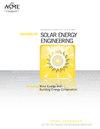金属卤化物灯高通量太阳模拟器的特性及偏差分析
IF 1.9
4区 工程技术
Q3 ENERGY & FUELS
Journal of Solar Energy Engineering-transactions of The Asme
Pub Date : 2023-08-14
DOI:10.1115/1.4063182
引用次数: 1
摘要
利用高度集中的太阳能进行热化学处理是地外原位资源利用(ISRU)的应用之一,已被强调为支持未来深空探测的重要技术。多源高通量太阳模拟器(HFSS)被广泛用于为室内太阳热实验提供稳定的辐照度。同时,已经开发了可以表征太阳热系统内辐射传输机制的数值模型,用于在现场试验前进行性能评估。然而,基于蒙特卡罗射线追踪(MCRT)方法开发的现有模型的模拟通量分布和测量通量分布之间存在显著差异,这仅归因于一两个特定原因。本文对斯温伯恩理工大学研制的42kW金属卤化物灯HFSS的浓度特性进行了综合分析,考虑了五个方面的影响。比较了不同配置下的通量分布、均匀性和矢量分布,以量化这些因素对接收辐照度的影响。合适的电弧尺寸、反射器形状、,和现有HFSS的反射器表面特性也进行了数值确定,以改进模型,并将灯阵列的均方根误差(RMSE)从38.2%降低到8.3%。这项研究为数值预测HFSS的辐射传输性能和确定所需太阳能热化学应用的合适配置提供了一条潜在的途径。本文章由计算机程序翻译,如有差异,请以英文原文为准。
Characterization and deviation analysis of a high-flux solar simulator with metal-halide lamps
Utilizing highly concentrated solar power for thermochemical processing as one of the extraterrestrial In-Situ Resource Utilization (ISRU) applications has been highlighted as an essential technique to support deep-space exploration in the future. Multi-source High-Flux Solar Simulators (HFSSs) are widely employed to provide stable irradiance for indoor solar thermal experiments. Meanwhile, numerical modeling that can characterize the radiation transport mechanisms within the solar thermal system has been developed for performance evaluation before field trials. However, significant differences between simulated and measured flux distributions were shown for existing models developed based on the Monte-Carlo Ray-tracing (MCRT) method, which have been attributed to only one or two specific reasons. In this paper, we proposed a comprehensive analysis of the concentration characteristics of a 42kW metal-halide lamp HFSS, developed at Swinburne University of Technology, considering the effect of five aspects. The flux distribution, uniformity, and vector distribution under different configurations were compared to quantify the influence of these factors on receiving irradiance. The suitable arc size, reflector shape, and reflector surface properties of the existing HFSS have also been numerically determined to improve the model and reduce the Root Mean Square Error (RMSE) for the lamp array from 38.2% to 8.3%. This research provides a potential pathway to numerically predict the radiation transfer performance of HFSSs and determine the suitable configuration for desired solar thermochemical applications.
求助全文
通过发布文献求助,成功后即可免费获取论文全文。
去求助
来源期刊
CiteScore
5.00
自引率
26.10%
发文量
98
审稿时长
6.0 months
期刊介绍:
The Journal of Solar Energy Engineering - Including Wind Energy and Building Energy Conservation - publishes research papers that contain original work of permanent interest in all areas of solar energy and energy conservation, as well as discussions of policy and regulatory issues that affect renewable energy technologies and their implementation. Papers that do not include original work, but nonetheless present quality analysis or incremental improvements to past work may be published as Technical Briefs. Review papers are accepted but should be discussed with the Editor prior to submission. The Journal also publishes a section called Solar Scenery that features photographs or graphical displays of significant new installations or research facilities.

 求助内容:
求助内容: 应助结果提醒方式:
应助结果提醒方式:


